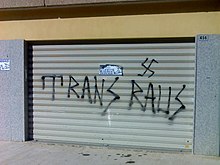
Back رهاب التحول الجنسي Arabic Трансфобія Byelorussian ট্রান্সফোবিয়া Bengali/Bangla Transfòbia Catalan ترانسفۆبیا CKB Transfobie Czech Trawsffobia Welsh Transfobi Danish Transphobie German Transfobi DIQ

| Part of a series on |
| Transgender topics |
|---|
|
|
| Part of a series on |
| LGBTQ topics |
|---|
|
|
| Part of a series on |
| Discrimination |
|---|
 |
Transphobia consists of negative attitudes, feelings, or actions towards transgender people or transness in general. Transphobia can include fear, aversion, hatred, violence or anger towards people who do not conform to social gender roles.[1][2] Transphobia is a type of prejudice and discrimination, similar to racism, sexism, or ableism,[3] and it is closely associated with homophobia.[4][5] People of color who are transgender experience discrimination above and beyond that which can be explained as a simple combination of transphobia and racism.[6]
Transgender youth often experience a combination of abuse from family members, sexual harassment, and bullying or school violence.[7] They are also disproportionately placed in foster care and welfare programs compared to their peers.[8] Adult transgender people regularly encounter sexual violence, police violence, public ridicule, misgendering, or other forms of violence and harassment in their daily lives.[9] These issues cause many trans people to feel unsafe in public. Other issues include healthcare discrimination, workplace discrimination or feeling under siege by conservative political or religious groups who oppose LGBT-rights laws.[10] Discrimination and violence sometimes originates from people within the LGBT community[11] or feminist movements.
As well as increased risk of violence and other threats, the stress created by transphobia causes negative mental health outcomes and lead to drug use disorders, running away from home (in minors), and suicide.
In much of the Western world, there has been a gradual establishment of policies combatting discrimination and supporting equal opportunity in all aspects of life since the 1990s. The trend is also taking shape in some developing nations. In addition, campaigns regarding the LGBT community are being spread around the world to improve social acceptance of nontraditional gender identities. The "Stop the Stigma" campaign by the UN is one such example.[12] However, transphobic violence has been on the rise since 2021,[13] accompanied with an increase in anti-trans discriminatory laws being enacted in many parts of the US and other countries.[14][15]
- ^ Chakraborti, Neil; Garland, Jon (2009). Hate Crime: Impact, Causes and Responses. SAGE Publications, Ltd. pp. 77. ISBN 978-1412945684.
- ^ Chrisler, Donald R.; McCreary, Joan C. (2010). Handbook of Gender Research in Psychology, Volume 2. Springer. p. 366. ISBN 978-1441913555.
- ^ Judith A. Lewis, Michael D. Lewis, Judy A. Daniels, Community Counseling: A Multicultural-Social Justice Perspective (2010, ISBN 113317003X)
- ^ Maurianne Adams; Lee Anne Bell; Pat Griffin (2007). Teaching for Diversity and Social Justice. Routledge. pp. 198–199. ISBN 978-1135928506. Retrieved 27 December 2014.
Because of the complicated interplay among gender identity, gender roles, and sexual identity, transgender people are often assumed to be lesbian or gay (See Overview: Sexism, Heterosexism, and Transgender Oppression). ... Because transgender identity challenges a binary conception of sexuality and gender, educators must clarify their own understanding of these concepts. ... Facilitators must be able to help participants understand the connections among sexism, heterosexism, and transgender oppression and the ways in which gender roles are maintained, in part, through homophobia.
- ^ Thomas Spijkerboer (2013). Fleeing Homophobia: Sexual Orientation, Gender Identity and Asylum. Routledge. p. 122. ISBN 978-1134098354. Retrieved 27 December 2014.
Transgender people subjected to violence, in a range of cultural contexts, frequently report that transphobic violence is expressed in homophobic terms. The tendency to translate violence against a trans person to homophobia reflects the role of gender in attribution of homosexuality as well as the fact that hostility connected to homosexuality is often associated with the perpetrators' prejudices about particular gender practices and their visibility.
- ^ Meyer, Doug (11 October 2015). Violence Against Queer People: Race, Class, Gender, and the Persistence of Anti-LGBT Discrimination. New Brunswick, New Jersey: Rutgers University Press. pp. 14–15. ISBN 9780813573182. OCLC 945735923.
- ^ GLSEN (October 2022). "The 2021 National School Climate Survey: The Experiences of LGBTQ+ Youth in Our Nation's Schools" (PDF).
- ^ "LGBTQ+ Youth | Los Angeles County Department of Children and Family Services". dcfs.lacounty.gov. Retrieved 22 October 2023.
- ^ What Constitutes Transphobic and Cisnormative Bullying and Harassment (PDF) (Report). Egale Canada. November 2019. Archived (PDF) from the original on 12 September 2022. Retrieved 12 September 2022.
- ^ Astor, Maggie (10 December 2022). "Transgender Americans Feel Under Siege as Political Vitriol Rises". The New York Times. ISSN 0362-4331. Retrieved 22 October 2023.
- ^ Cite error: The named reference
weiss2004was invoked but never defined (see the help page). - ^ "Tackling Discrimination on Grounds of Sexual Orientation and Gender Identity" (PDF).
- ^ Williamson, Harriet (9 September 2023). "Transphobia is on the rise – and the press is to blame". PinkNews. Retrieved 22 October 2023.
- ^ Evdokimova, Tamara (10 July 2023). "The global rise of anti-trans legislation". Coda Story. Retrieved 22 October 2023.
- ^ "2023 Anti-Trans Bills: Trans Legislation Tracker". translegislation.com. Retrieved 22 October 2023.